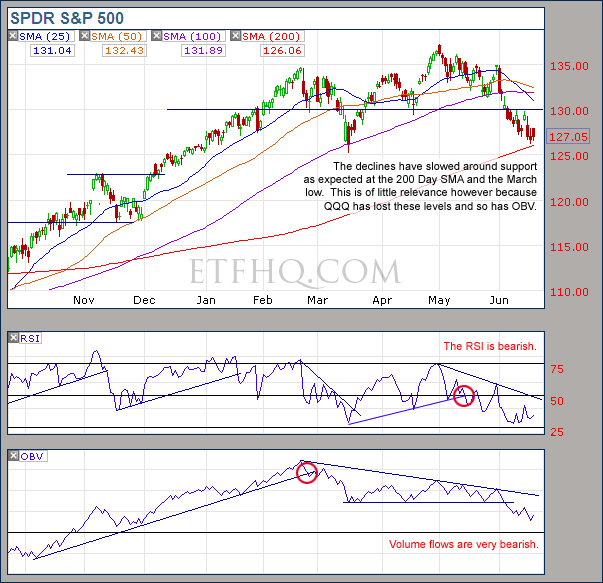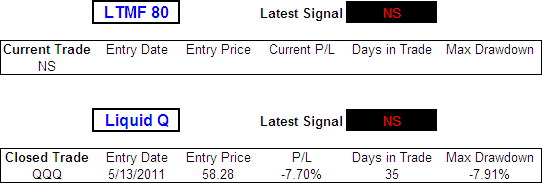June 20, 2011 – 08:55 am EDT
The declines slowed over the last week in several areas of the market as support levels were encountered. Some major damage has been done however due to failure at some significant levels and escalating bearish volume. Lets take a closer look…
.
ETF % Change Comparison
.

SMH and QQQ lead the market lower over the last week with both finishing the week at lower lows. These are two particularly influential and economically sensitive ETFs so to see money moving from these areas into the relative safety of SPY and DIA is very bearish. It is surprising to see the Transports (IYT) doing so well however which reminds us that the market is unlikely to fall off a cliff any time soon.
Learn more – ETF % Change Comparison
.
![]()
.
A Look at the Charts
.

Don’t get excited about SPY holding onto support, it is a hollow victory.
.

Strongly bearish volume and a loss of support… Not good QQQ
.

Keep an eye on SMH, support still remains despite significant technical damage.
.

A close above $80 could trigger a short run by the bulls.
.

It will be interesting to see if $95 becomes resistance for IYT.
.
![]()
.
OM3 Weekly Indicator
.

The OM3 indicator remains bearish across the board.
Learn more – The OM3 Indicator
.
![]()
.
TransDow & NasDow
.

TransDow – The Transports have regained dominance over the Dow and a new position was opened in DJT on Friday.
NasDow – The NasDow continues to offer no signal for a second week.
.
What the TransDow Readings tell us:
The TransDow measures dominance between the DJ Transportation Index (DJTI) and the Dow Jones Industrial Average (DJIA). In a strong market the more economically sensitive Transportation Index should be dominant over the DJIA.
Historically the DJTI has been dominant over the Dow 45% of the time. The annualized rate of return from the DJTI during this period was 18.47% with the biggest loss for one trade sitting at -13.27%. The annualized return from the DJIA during the periods it was dominant over the DJTI was just 4.06% and the biggest loss for one trade was -16.13%. A 4% stop-loss is applied to all trades adjusting positions only at the end of the week.
What the NasDow Readings tell us:
The NasDow measures dominance between the NASDAQ and the DJIA. Using the same theory behind the Trans Dow; in a strong market the more economically sensitive NASDAQ should be dominant over the DJIA.
Historically the NASDAQ has been dominant over the DJIA 44% of the time. Taking only the trades when the NASDAQ is above its 40 week moving average the annualized rate of return was 25.47% with the biggest loss for one trade sitting at –8.59%. The annualized rate on the DJIA during the periods it was dominant over the NASDAQ is just 8.88% and the biggest loss for one trade was –12.28%. A 8% stop-loss is applied to all trades adjusting positions only at the end of the week.
.
![]()
.
LTMF 80 & Liquid Q
.

Liquid Q finally closed out its position in QQQ for a nasty 7.7% loss. LTMF 80 remains in cash.
.
Historical Stats:
.

.
How The LTMF 80 Works
LTMF stands for Long Term Market Forecaster. It reads volume flows relative to price action and looks for out performance of volume measured on a percentage basis over the prior 12 months. During a sustained rally the readings will reach high levels (near 100%) making it imposable for the volume reading to always outperform price so any reading above 80% will maintain the buy signal. This system has outperformed the market over the last 10 years but performance has been damaged by some nasty losses. It only produces buy signals and only for QQQ.
How Liquid Q Works
Liquid Q completely ignores price action and instead measures the relative flow of money between a selection of economically sensitive and comparatively stable ares of the market. It looks for times when the smart money is confident and and can be seen by through volume investing heavily is more risky areas due to an expectation of expansion. This system has outperformed the market over the last 10 years and remained in cash through most of the major declines. It only produces buy signals and only for QQQ. We will provide more performance details on the web site for these systems soon.
.
![]()
.
Summary
On a positive note the Small caps are holding onto support and IYT has been seeing some real buying interest. This suggests that we are unlikely to encounter an all out market collapse any time soon due to a Greek default or anything else. However the action from SMH and QQQ is disturbing to say the least and further declines are highly likely.
Any disputes, questions, queries, comments or theories are most welcome in the comments section below.
.
Cheers
Derry
And the Team @ ETF HQ
“Equipping you to win on Wall St so that you can reach your financial goals.”
.
![]()
.
Quote of the Day
“Does history record any case in which the majority was right?” – Robert Heinlein
.
.
QID, TZA and SOXS have been profitable since the up trend line break of May 2nd… 🙂
Well played Mike.